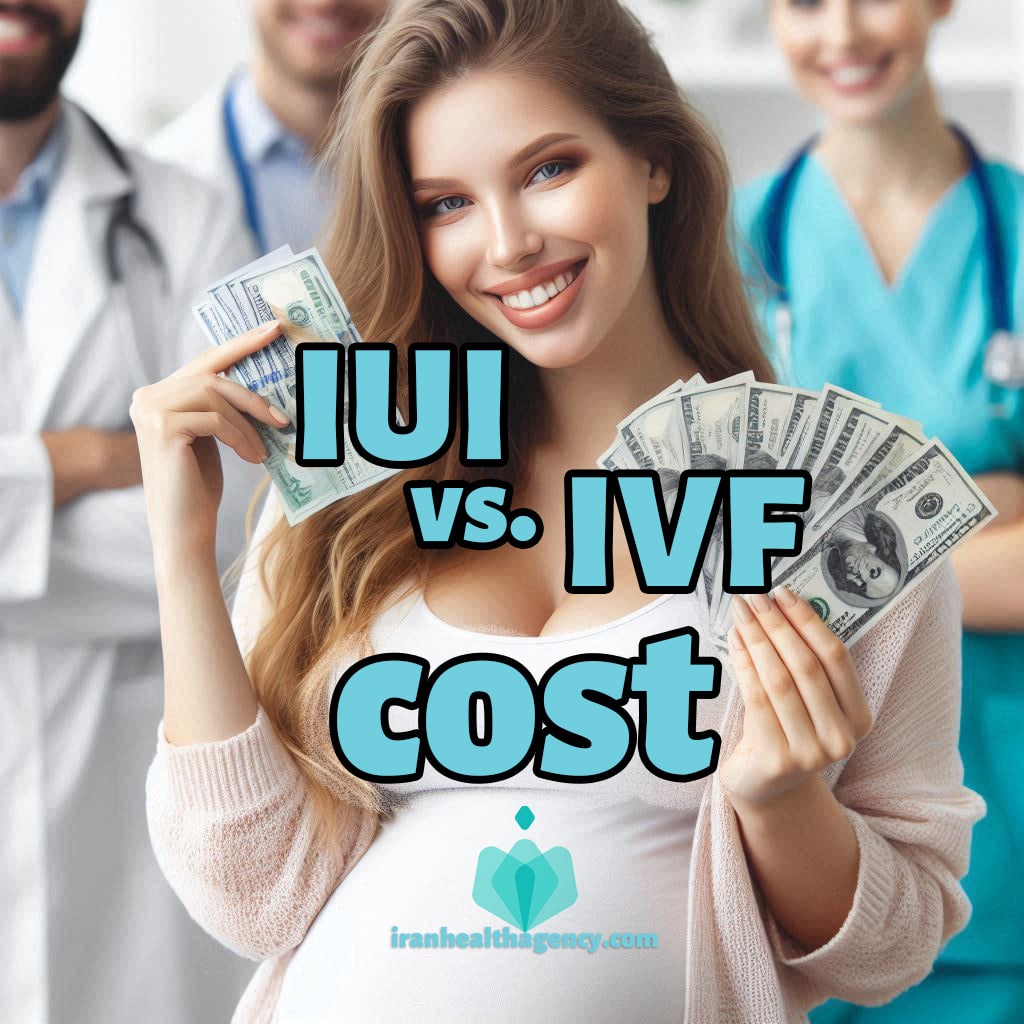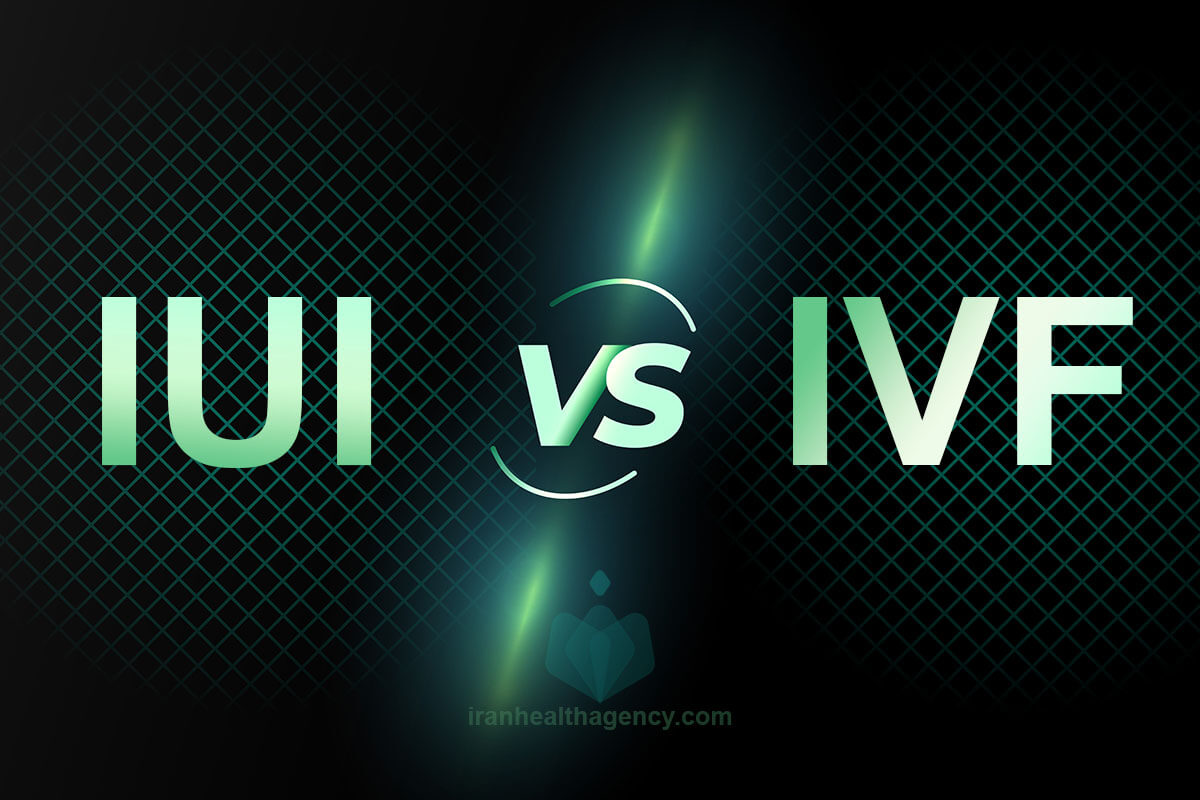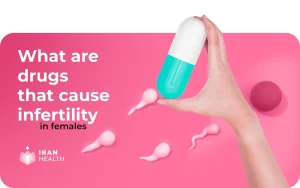Experts at IranHealthAgency compare these two treatments, offering expert guidance on selecting the right option for patients seeking IVF IN Iran.
IUI vs. IVF Success Rate
IVF usually has higher success rates when you look at the IUI success rates. The success rate of IUI changes a lot with age:
| Female Patient’s Age | IUI Success Rate | IVF Success Rate |
| Under 35 | 13% | 54% |
| 35–37 | 10% | 40% |
| 38–40 | 7% | 26% |
| Over 40 | 4% | 8% |

Before this, we talk about the IVF success rate factor. For the most part, IVF works better than other methods because it uses direct fertilization of eggs in a lab, where the process can be better managed.
IUI vs. IVF Cost
The cost of IUI is significantly lower than that of IVF. Here is a comparison of the costs involved:
| Treatment | Cost (excluding medications) |
| IUI | $1,000 |
| IVF | $12,000–$20,000 |
Medications for IUI, such as Clomid or letrozole, cost about $30–$75 per cycle, whereas injectable medications for IVF can range from $2,000 to $6,000.

Notice:
The cost of IVF in Iran is becoming increasingly affordable. This could be great news for those considering fertility treatments. “Looking for more details? Check out the page on IVF in Iran for all the information you need.”
IUI Treatment Procedure
As we said at the beginning of the blog, a popular way to treat infertility is IUI, which involves putting sperm directly into a woman’s uterus to increase her chances of getting pregnant. This treatment is often suggested to couples who are having trouble getting pregnant for many reasons, such as infertility that can’t be explained, mild male factor infertility, or problems with ovulation.
Here is a thorough look at how IUI treatment works:
IUI Full Form
How to Do It Step by Step? Here is an entire forum for you:
- First appointment and diagnostic tests
The first step is to meet with a fertility specialist. They will look over your medical background and talk to you about your family-building goals. To make sure the fallopian tubes are open and the uterus looks fine, diagnostic tests like a saline infusion sonogram (SIS) or hysterosalpingogram (HSG) may be done.
- Stimulation of Ovulation
During IUI, the woman’s ovulation period is usually taken into account. To get the egg to release, fertility drugs like Clomid or letrozole may be given. Ultrasounds and blood tests are done regularly to check on the growth of the eggs and find the best time to inseminate.
- Getting Sperm and Getting It Ready
Sperm from the male partner or a donor that has been thawed is taken on the day of the operation. The sample is then “washed” to get rid of the seminal fluid, which can cause cramps if put into the uterus, and focus the healthy sperm.
- Procedure for Insemination
The process of insemination is quick and doesn’t hurt too much. This is how it usually goes:
- The woman is lying on an exam table with her legs raised.
- Like a Pap test, a speculum is put into the vagina to keep it open.
- Then, a thin, bendable tube is put into the uterus through the cervix.
- To get the sperm sample into the uterus, the tube is used to push the sample through.
- After removing the tube and speculum, the woman can rest briefly before returning to her normal routine.
Is IUI Painful?
A lot of people think that IUI is a process that doesn’t hurt and doesn’t require much surgery. There may be some minor cramping or pain for some women when the catheter is put in, but most don’t need anesthesia and can handle the pain.
When is IUI Recommended?
Whether to try intrauterine insemination (IUI) first or in vitro fertilization (IVF) relies on some things, such as the reason for the infertility, the age of the couple, and any health problems they may have.
When might it be best to use IU?
- Mild Male Infertility: IUI can work when there are only minor problems with the number or movement of sperm because it sends the sperm straight into the uterus, skipping any possible issues.
- Problems with the cervix: If the mucus in the cervix is not friendly to sperm, IUI can help by putting sperm straight into the uterus.
- Ovulation Disorders: IUI may help women who have problems with ovulation, primarily when used with medicines that make ovulation happen.
- When the reason for infertility is not clear, IUI is often the first treatment that is tried.
- Couples who need donor sperm should choose IUI over IVF because it is easier and less invasive.
Should You Try IUI Before IVF?
Some kinds of infertility, like infertility that can’t be explained, mild male factor infertility, or problems with ovulation, are often treated with IUI first. It is less painful and expensive than IVF so it can be used as a first choice. Most of the time, doctors tell women under 35 that they should try 3 to 6 rounds of IUI before they consider IVF.
Chance of Twins: IUI vs. IVF

One of the central questions of IHA’s patents is the chance of twins in IUI and IVF.
Because drugs that make the ovaries make more eggs are used in fertility treatments, the chance of having twins or more is usually higher.
If fertility drugs are used to make the woman ovulate during IUI, the possibility of having twins goes up. However, IUI by itself does not naturally raise the risk of having twins compared to natural conception. Multiples can also happen with IVF, especially if more than one embryo is moved during the process.
Conclusion
IUI vs. IVF: Which one is better for you? We will answer your question again at the end of this piece to get your answer directly!
Choosing between IUI and IVF depends on various factors, including the underlying cause of infertility, age, financial considerations, and personal preferences. IUI is less invasive and less costly but has lower success rates compared to IVF. IVF, while more expensive and invasive, offers higher success rates and is suitable for more complex infertility issues.
So, to know about IUI vs. IVF, just talk with your fertility doctor and don’t decide without consulting them.
IUI in Iran
IUI in Iran is a common and inexpensive way to treat infertility. The process is the same as it is in other countries: sperm are collected, washed, and then put into the uterus. The cost and success rate are about the same as those found in different countries, which makes it a choice that many couples seeking fertility treatment can afford.
In conclusion, both IUI and IVF offer advantages and disadvantages. Consulting with a fertility specialist can guide your decision based on your unique needs and objectives.
Resources:
- https://www.verywellhealth.com/iui-vs-ivf-procedure-cost-and-success-rate-7094016
- https://www.hopkinsmedicine.org/gynecology-obstetrics/specialty-areas/fertility-center/infertility-services/intrauterine-insemination
- https://www.nhs.uk/conditions/artificial-insemination/



